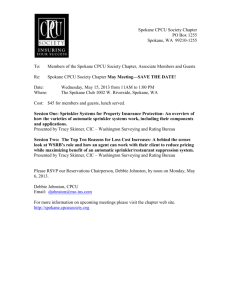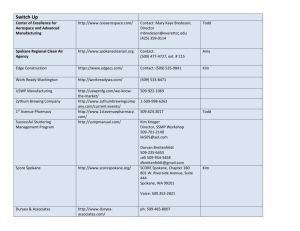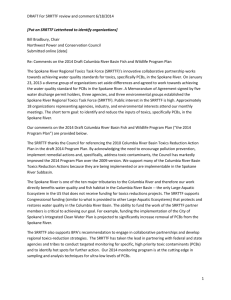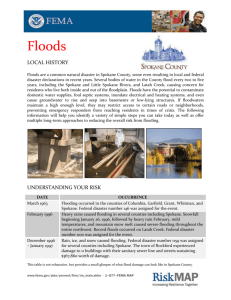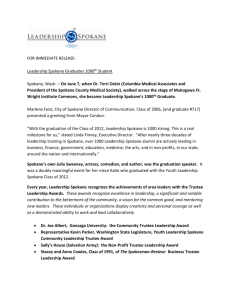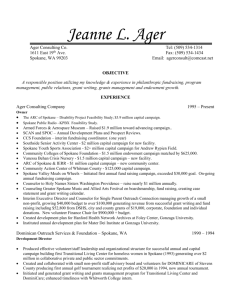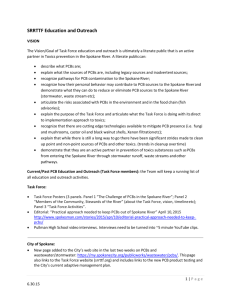Public Health Risks in the Spokane RiverChemicals and Heavy Metals
advertisement
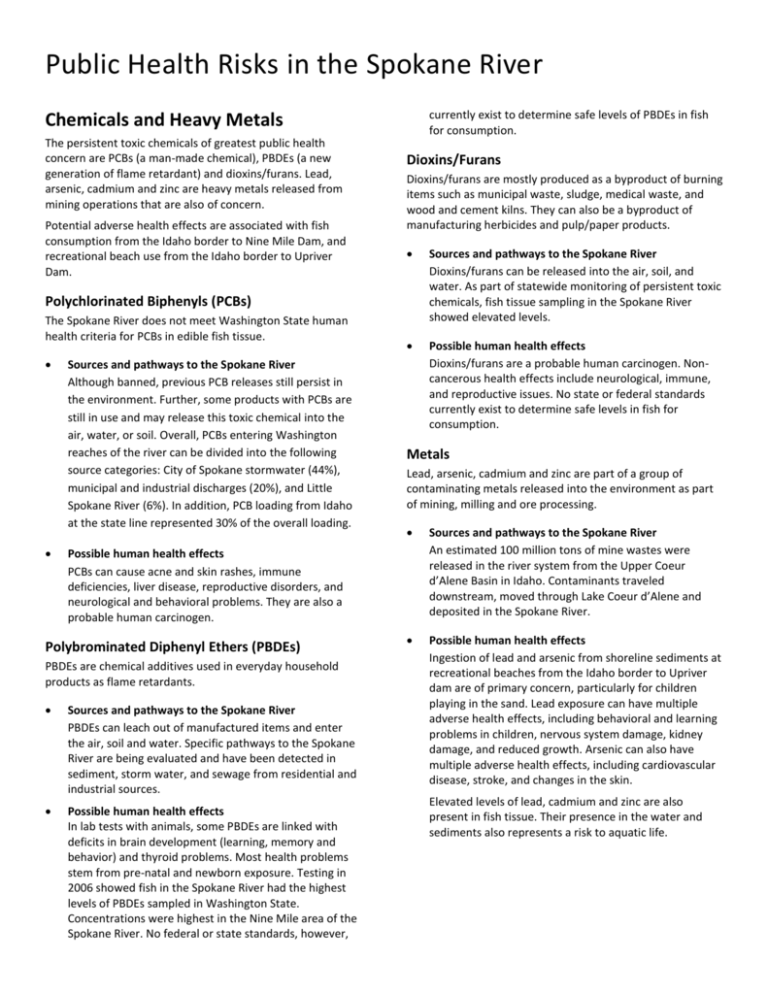
Public Health Risks in the Spokane River currently exist to determine safe levels of PBDEs in fish for consumption. Chemicals and Heavy Metals The persistent toxic chemicals of greatest public health concern are PCBs (a man-made chemical), PBDEs (a new generation of flame retardant) and dioxins/furans. Lead, arsenic, cadmium and zinc are heavy metals released from mining operations that are also of concern. Potential adverse health effects are associated with fish consumption from the Idaho border to Nine Mile Dam, and recreational beach use from the Idaho border to Upriver Dam. Dioxins/Furans Dioxins/furans are mostly produced as a byproduct of burning items such as municipal waste, sludge, medical waste, and wood and cement kilns. They can also be a byproduct of manufacturing herbicides and pulp/paper products. Sources and pathways to the Spokane River Dioxins/furans can be released into the air, soil, and water. As part of statewide monitoring of persistent toxic chemicals, fish tissue sampling in the Spokane River showed elevated levels. Possible human health effects Dioxins/furans are a probable human carcinogen. Noncancerous health effects include neurological, immune, and reproductive issues. No state or federal standards currently exist to determine safe levels in fish for consumption. Polychlorinated Biphenyls (PCBs) The Spokane River does not meet Washington State human health criteria for PCBs in edible fish tissue. Sources and pathways to the Spokane River Although banned, previous PCB releases still persist in the environment. Further, some products with PCBs are still in use and may release this toxic chemical into the air, water, or soil. Overall, PCBs entering Washington reaches of the river can be divided into the following source categories: City of Spokane stormwater (44%), municipal and industrial discharges (20%), and Little Spokane River (6%). In addition, PCB loading from Idaho at the state line represented 30% of the overall loading. Metals Lead, arsenic, cadmium and zinc are part of a group of contaminating metals released into the environment as part of mining, milling and ore processing. Sources and pathways to the Spokane River An estimated 100 million tons of mine wastes were released in the river system from the Upper Coeur d’Alene Basin in Idaho. Contaminants traveled downstream, moved through Lake Coeur d’Alene and deposited in the Spokane River. Possible human health effects Ingestion of lead and arsenic from shoreline sediments at recreational beaches from the Idaho border to Upriver dam are of primary concern, particularly for children playing in the sand. Lead exposure can have multiple adverse health effects, including behavioral and learning problems in children, nervous system damage, kidney damage, and reduced growth. Arsenic can also have multiple adverse health effects, including cardiovascular disease, stroke, and changes in the skin. Possible human health effects PCBs can cause acne and skin rashes, immune deficiencies, liver disease, reproductive disorders, and neurological and behavioral problems. They are also a probable human carcinogen. Polybrominated Diphenyl Ethers (PBDEs) PBDEs are chemical additives used in everyday household products as flame retardants. Sources and pathways to the Spokane River PBDEs can leach out of manufactured items and enter the air, soil and water. Specific pathways to the Spokane River are being evaluated and have been detected in sediment, storm water, and sewage from residential and industrial sources. Possible human health effects In lab tests with animals, some PBDEs are linked with deficits in brain development (learning, memory and behavior) and thyroid problems. Most health problems stem from pre-natal and newborn exposure. Testing in 2006 showed fish in the Spokane River had the highest levels of PBDEs sampled in Washington State. Concentrations were highest in the Nine Mile area of the Spokane River. No federal or state standards, however, Elevated levels of lead, cadmium and zinc are also present in fish tissue. Their presence in the water and sediments also represents a risk to aquatic life. Spokane River Clean up and Restoration Clean up and restoration activities of popular shoreline areas began in 2006. At the Starr Road Recreation area, a combination of digging out and reconstruction of shoreline areas and capping was used. This isolates the public from exposure to lead and arsenic while also restoring important aquatic habitat. Metals were also capped and isolated from the river environment behind Upriver Dam as part of the PCB cleanup work. Beach recreation sites related to the Coeur d’Alene Basin metals cleanup action under the Record of Decision for the Spokane River: Completed sites: Starr Road (2006): EPA Lead Site Island Complex (2007): State Lead Site Murray Road (2007): State Lead Site Harvard Road North (2008): State Lead Site Flora Road (2009): State Lead Site Pending sites (state lead): Barker Road North Barker Road South Myrtle Point Islands Lagoon These sites have received funding; cleanup (likely capping) for all four remaining sites is scheduled during late summer 2012, during low river flows. Completed PCB sites: Upriver Dam (2006): State Lead Site This site was capped. This remedy will also likely address the metals contamination (basin-related) that had accumulated behind the dam along with the PCBs. Donkey Island (2007): State Lead Site Biological Hazards Illnesses potential from biological organisms is possible with any natural body of water. Illness potential on the Spokane River increases with raw sewage discharges, livestock runoff, abundant waterfowl and aquatic mammals. Increased illness potential is associated with impaired water quality from high organic and nutrient loads. Intestinal microorganisms Elevated levels of indicator bacteria, such as E. Coli and enterococcus, is associated with gastroenteritis from recreational water. The following microorganisms have been known to cause illness associated with recreational water use: Giardia* Cryptosporidium* Shigella* Salmonella* Hepatitis A* Coxackie A and B Norwalk virus E.coli 0157:H7* Leptospirosi Other microorganisms Found in the environment which cause infections or diseases Pseudomonas aeruginosa Schistosome cercarial Staphylococcus sp. Legionella sp.* Naegleria fowleri Mycobacterium sp. Vibrio sp.* *reportable For more information, contact: Mike LaScuola Environmental Health Specialist Spokane Regional Health District 509.324.XXXX mlascuola@spokanecounty.org Presentation to the Board of Health, July 28, 2011
